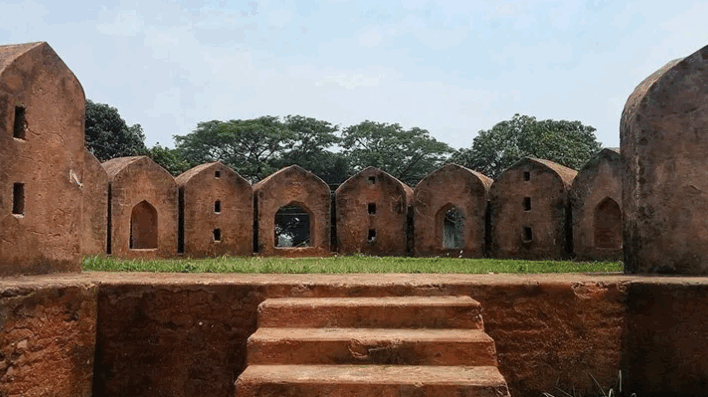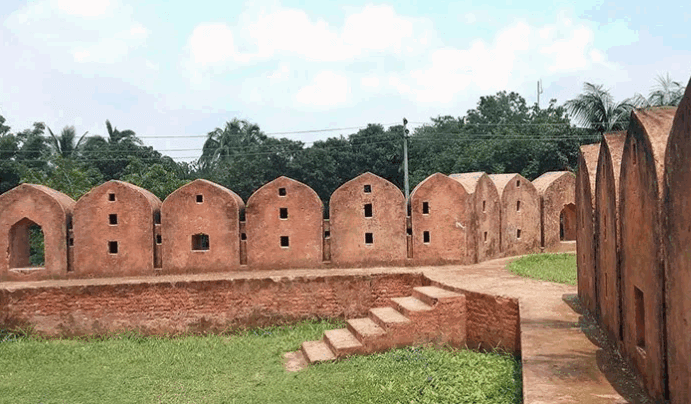Hajiganj Fort, also known as Khizirpur Fort, is a captivating Mughal-era water fort located in the heart of Narayanganj, Bangladesh, on the western bank of the Shitalakshya River. Built in the 17th century, this historical landmark stands as a testament to the Mughal Empire’s strategic brilliance in defending Dhaka against Magh and Portuguese pirate raids.
Known locally as “Hajiganj Kella,” the fort’s unique hexagonal design, pentagonal curtain walls, and lotus-decorated gateway make it a must-visit for history enthusiasts, architecture lovers, and travelers seeking a glimpse into Bangladesh’s rich past. This article explores the fort’s history, architectural highlights, and a detailed travel guide to help you plan a visit, perfect for boosting your blog’s search engine ranking.

The Historical Significance of Hajiganj Fort
Hajiganj Fort was likely constructed soon after Subahdar Islam Khan established Dhaka as the Mughal capital in the early 17th century, though some sources attribute it to Mir Jumla’s era around 1650. Positioned at the confluence where the old Buriganga River discharged into the Shitalakshya, it was part of a “Triangular Water Fort” system alongside Sonakanda Fort (Narayanganj) and Idrakpur Fort (Munshiganj). These forts were designed to protect Dhaka, a thriving trade hub, from river-based pirate attacks. The fort’s strategic location and robust defenses highlight the Mughals’ innovative approach to safeguarding their capital. Today, it serves as the Fire Brigade headquarters of Narayanganj, yet its historical charm remains intact, drawing visitors to its weathered walls and serene riverside setting.

Architectural Highlights of Hajiganj Fort
Hajiganj Fort is a quadrangular structure with a distinctive pentagonal curtain wall, featuring rounded corner bastions designed for musket and cannon fire. Key architectural elements include:
-
Pentagonal Curtain Wall: The fort’s walls are machicolated for muskets, with a 1.22-meter-high rampart walkway pierced by musketry holes for defense.
-
Rounded Bastions: Six corner bastions, three larger ones facing the river, were built to house cannons, with staircases leading to the rampart level for patrol and firing.
-
Lotus-Decorated Gateway: The sole entrance, facing the Shitalakshya River, is a pentagonal gateway set in a rectangular frame, adorned with engraved arches and a lotus finial, reflecting Mughal aesthetic influences.
-
Observatory Tower: A tall, freestanding brick column inside the fort likely served as a watchtower, used for surveillance and cannon placement during the rainy season.
-
Empty Interior: The absence of permanent structures suggests the fort was occupied seasonally, with tents used for shelter during pirate-prone monsoon periods.
The fort’s hexagonal layout and river-facing design emphasize its role as a water fort, accessible primarily by boat, offering a unique glimpse into Mughal military architecture. Its proximity to the river and the nearby Kadam Rasul Mazar adds to its cultural allure.
Travel Guide to Hajiganj Fort
How to Get to Hajiganj Fort
Located just 28.1 km from Dhaka (a 47-minute drive), Hajiganj Fort is easily accessible from the capital, making it an ideal day trip destination. Here’s how to reach it:
-
From Dhaka to Narayanganj:
-
By Bus: Board a BRTC, Bandhan, Ekata, or Ullash bus from Dhaka’s Gulistan, Motijheel, or Sayedabad bus terminals to Chashara, Narayanganj. The fare is approximately BDT 40 (non-AC) or BDT 55 (AC). The journey takes about 45–60 minutes, depending on traffic.
-
By Train: Take a suburban train from Dhaka’s Kamalapur Railway Station to Chashara Station. Tickets cost around BDT 20–30, and the ride takes about 30–40 minutes.
-
By Car: Drive via the Dhaka-Narayanganj Link Road. Set your GPS to “JGM7+C5G, Narayanganj” for precise navigation. Parking is available near the fort.
-
-
From Chashara to Hajiganj Fort:
-
From Chashara, hire a rickshaw or CNG auto-rickshaw to Hajiganj Kella (locally known as “Kella” rather than “Durgo”). The fare is BDT 10–20 for a rickshaw or BDT 100–150 for a CNG for up to two people. The fort is near the Narayanganj Fire Service Office and Gudaraghat.
-
Alternatively, enjoy a scenic 10–15-minute walk from Chashara to the fort, following signs to Kella Road or asking locals for “Hajiganj Kella.”
-
-
By Boat: For a unique experience, take a canopy boat from Gudaraghat across the Shitalakshya River to explore the fort’s riverside setting. Boat fares are around BDT 5–10 per person.
GPS Coordinates: 23°38’1.17″N, 90°30’46.53″E
Where to Stay
Narayanganj offers modest accommodation options suitable for short visits:
-
Hotel Shurma: Located at 17 Shahid Sohrawardi Road, Narayanganj, with rooms starting at BDT 500–1,000 per night.
-
Budget Hotels in Chashara: Several guesthouses offer rooms for BDT 300–800, ideal for budget travelers.
-
Dhaka Options: For more comfort, stay in Dhaka at hotels like Hotel 71 (BDT 3,000–4,000) or Golden Tulip The Grandmark Dhaka in Banani (BDT 5,000–7,000), a 45-minute drive away.
Where to Eat
Dining options near Hajiganj Fort are limited, but you can find local cuisine in Narayanganj’s Bandar area:
-
Local Restaurants: Small eateries near Chashara and Bandar Ghat serve traditional Bangladeshi meals like rice, fish curry, and kebabs for BDT 100–200 per person.
-
Street Food: Try local snacks like fuchka or jhal muri near Gudaraghat for BDT 20–50.
-
Dhaka Dining: For upscale options, return to Dhaka and dine at restaurants like Woodhouse Grill or Cielo Rooftop in Banani, offering continental and local dishes for BDT 1,000–2,000 per person.
Nearby Attractions
Enhance your trip by exploring these nearby sites:
-
Sonakanda Fort: Located on the eastern bank of the Shitalakshya River in Bandar, Narayanganj, this Mughal fort is accessible by a short boat ride (BDT 1–2) from Bondor Ghat.
-
Panam Nagar: A historic township in Sonargaon, 15 km from Narayanganj, featuring colonial-era buildings. Reach it by bus or rickshaw from Chashara for BDT 50–100.
-
Kadam Rasul Mazar: A shrine near Hajiganj Fort, accessible by a short walk or boat from Gudaraghat, offering spiritual and cultural significance.
-
Murapara Palace: A stunning colonial-era palace in Rupganj Upazila, about 20 km from the fort, ideal for a day trip.
Visiting Tips
-
Best Time to Visit: October to March offers pleasant weather (20–30°C) for exploring the fort. Visit early morning (10:00 AM–12:00 PM) or late afternoon (3:00 PM–5:00 PM) for cooler temperatures and better lighting for photography. The fort is open daily from 10:00 AM to 5:00 PM.
-
What to Bring: Wear comfortable shoes for uneven surfaces, bring a camera for the fort’s architecture and river views, and carry water and snacks, as facilities are limited.
-
Safety: Avoid visiting at night due to limited security and potential for loitering. The area is generally safe during the day but exercise caution with valuables.
-
Hire a Guide: Local guides, available near the fort for BDT 200–500, can provide detailed insights into its history and Mughal architecture.
-
Budget: Expect to spend BDT 500–1,000 per person for a day trip from Dhaka, including transport, food, and entry (no entry fee for the fort).
-
Respect the Site: The fort is a historical monument now used as a Fire Brigade headquarters. Avoid littering and follow local guidelines to preserve its condition.
Why Hajiganj Fort Stands Out
Hajiganj Fort is a remarkable example of Mughal defensive architecture, blending functionality with aesthetic elements like its lotus-adorned gateway and strategic riverfront location. Its role in protecting Dhaka from pirate raids adds historical intrigue, while its compact, well-preserved structure offers a quick yet enriching visit for travelers. The fort’s proximity to other attractions like Sonakanda Fort and Panam Nagar makes it an excellent anchor for a historical tour of Narayanganj. Despite its current use as a Fire Brigade headquarters, the fort retains an air of timelessness, inviting visitors to imagine its bustling past during the Mughal era.
Also Visit: Mayadip Travel Guide
Conclusion
Hajiganj Fort Kella in Narayanganj is a hidden gem that offers a fascinating glimpse into Bangladesh’s Mughal history. Its unique hexagonal design, strategic riverside location, and historical significance make it a must-visit for anyone exploring the Dhaka region. With easy access from the capital, affordable transport options, and nearby attractions like Panam Nagar and Sonakanda Fort, Hajiganj Fort is perfect for a day trip filled with history and scenic beauty. Plan your visit, capture the fort’s architectural charm, and immerse yourself in the vibrant heritage of Narayanganj!
Note: Always check bus and train schedules in advance, as traffic and weather may affect travel times. Respect local regulations when visiting historical sites.
